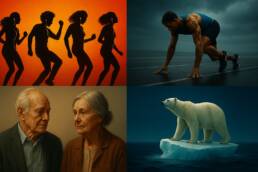Introduction: why words aren't always necessary
Words can describe, but images make you feel instantly. A story told through pure visual video has the advantage that it doesn’t require cognitive effort; you don’t have to read, translate, or decode. All you do is see and feel.
Imagine two scenarios:
- A descriptive text: “She lifted her son into her arms after months of waiting. Tears streamed down her cheeks, and the child laughed heartily, with his arms outstretched.”
- A 5-second video of a mother picking up her child, their faces full of emotion.
Which of the two makes you gasp sooner?
Obviously, the image. Because you aren’t forced to translate it into words; you just get to experience the emotion.
In an age of short attention spans, where people scroll through hundreds of posts a day with a single finger, the visual story is the only one that can grab them instantly. And when it’s told well, it needs no explanation.

The universal language of images
Visual stories are the genetic code of human communication. Before we knew how to write, we drew hunting scenes and rituals on cave walls. These drawings weren’t just art; they were stories passed down to the community.
Why were they effective? Because they didn’t need explanations. People from one tribe would understand the symbols just as well as people from another, even if they didn’t speak the same language.
The same rule works today. If you show a smiling face, it’s understood the same way in Tokyo, Paris, or Bucharest. If you show an outstretched hand, everyone understands the gesture of help. Pure visual video is the universal language; it doesn’t need to be translated.
That’s why global brands create visual ads that work in any culture. It’s not because they avoid words, but because they know that an image has a more direct power.

Unspoken emotions: how visuals affect the subconscious
It’s a proven fact that emotion is processed before reason. The brain reacts to expressions, colors, and movements in a fraction of a second, before you even have time to think.
- Facial expressions: When you see someone crying, the mirror neurons in your brain make you feel empathy. You don’t need to read “this person is sad.” You feel it.
- Light and color: A scene filmed in a cool blue conveys distance and mystery. One filmed in a warm orange conveys safety and intimacy.
- Movement: A slightly shaky camera conveys tension. Slow motion conveys melancholy.
All these details are read by the subconscious without you even realizing it. That’s why pure visual storytelling has the power to get to where words can’t.

Famous examples of wordless storytelling
The best visual stories are the ones that don’t explain, but show.
- Apple – iPod Silhouettes: Just colorful silhouettes dancing on vibrant backgrounds. Without a single word, the message was clear: iPod = the freedom to express yourself through music.
- Nike – Just Do It: Spots where you see athletes who fall, get back up, and keep going. There’s no need to say “perseverance matters.” You see it. You feel it.
- Pixar (“Up”): The first few minutes of the film tell the story of a couple’s life. With almost no dialogue, it’s probably the most emotional animated sequence ever created.
- WWF – The Polar Bear: A simple image: a polar bear on a melting glacier. No text, no narrator. Instant emotional impact.
👉 All these examples have something in common: the audience completed the story on their own. This makes the experience more powerful, because you weren’t told what to think; you felt it yourself.

How brands can use pure visual storytelling
A brand can integrate pure visual storytelling into any type of content if it understands the principle: show, don’t tell.
- Products: Instead of saying “our chocolate is creamy and delicious,” show a piece slowly breaking, the cream flowing, the face of someone smiling after the first bite.
- Services: Instead of saying “we help customers save time,” show a father leaving the office early and making it to pick up his child from school.
- Social Campaigns: Instead of saying “plastic pollutes the oceans,” show a turtle trapped in a net. The audience will feel more than they would by reading statistics.
👉 The strength of this type of storytelling is that it replaces rational argument with emotional experience.

Conclusion: When silence speaks louder than words
The most powerful stories are not always the ones that explain in detail, but the ones that leave room for interpretation.
A simple shot, a glance, a gesture, a light, can be more powerful than any slogan. Because in that moment, the audience becomes a co-author of the story. They complete the message with their own emotions, memories, and experiences.
At Cabo Studio, we believe that the true art of storytelling is to create images that not only show, but make people feel. Because visual emotions don’t need translation. They speak directly to the subconscious.
